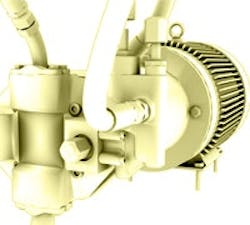Hydraulics Get Better With Age
Stick with what you know. Dance with the girl you brought. Don’t rock the boat.
Just like these old sayings, hydraulics as a power source has been around for a long time. Some accounts of its use by the Chinese date back more than 26 centuries.
But change can be good. While hydraulics hasn’t changed too much over the years, hydraulic controls seem to take leaps from time to time, as long as they don’t interrupt production.
Used for high-power density, hydraulic systems have improved over the years, offering tighter tolerances and better fault-sensitivity. As a result of this improved performance, necessary field operator skills have increased to the point where certification is all but required. Cleanliness of the fluid and the hoses or pipes that transport it also becomes more important, as does temperature control.
When the original manufacturer stopped supporting the 30-year-old analog-based control system at New Zealand Steel (www.nzsteel.co.nz) in Auckland, New Zealand, control of the production lines had to be modernized.
“We’re something of a boutique steelmaker, producing small tonnage runs for near-just-in-time customer delivery, so no interruption of production was feasible,” explains Damian Little, principal engineer at New Zealand Steel. “Consequently, Global Hydraulics & Controls built a freestanding shadow mill stand with a Moog control system to fully validate the design before modifying the production line.”
[pullquote]
The new control system has been used successfully for almost two years, but the nuances of hydraulic control weren’t without their challenges.
“To meet customer specifications, our cold-rolled annealed strips are given the desired surface finish in a skin pass mill,” explains Little. “It improves flatness while suppressing yield-point elongation. Anti-rust oil is used on strip surface as protection from rust. A single, two-high skin pass mill varies the force to complete its final finish and thickness.”
The process control requires the roll to be lifted onto the sheet for a “kiss” before applying a controlled load. Conceptually simple, the control is complex in practice.
“One side of the roll, although synchronously controlled, will reach the sheet before the other due to misalignment errors caused by measurement limitations or different play in the roll bearings,” explains Little. “We synchronously lift each side of the roll onto the sheet under position control with a low-level force override.”
The roll is lifted up to the sheet, but is limited by a force override outer control loop until both sides of the roll make contact and the bearing play in the top roll is taken up, he says.
The initial force is enough to lift both rolls but not enough to risk grabbing or jamming the sheet and ruining product or losing hours of production. “With the old system we had as many as six strip breaks in a year, due to grabbing, whereas in the past two years we’ve had none due to hydraulics,” says Little.
Once both sides are in contact and all bearing play is removed, the force is ramped to the required process level with near-zero overshoot. “Low-level control—the skin pass roll control—is implemented using the digital microprocessor-based controller,” he says. “The control strategy implemented was developed specifically for this production line based on a detailed analysis of all operational modes of the process.”
The controller provides the closed-loop position movement and force control for the skin pass roll and also includes management of the auxiliary hydraulic valves operating the actuators and the supporting hydraulic power unit, explains Little.
The new system replaced the existing, servo-valve manifold assemblies, which control each of the load cylinders. “These are effectively displacement rams, relying on the weight of the roll to retract,” he says. However, when the system is in emergency mode, a powered retract is required to move the roll off of the sheet quickly and reliably.
Change can be good. And change is even better when, as in this particular case, it doesn’t interrupt production.


